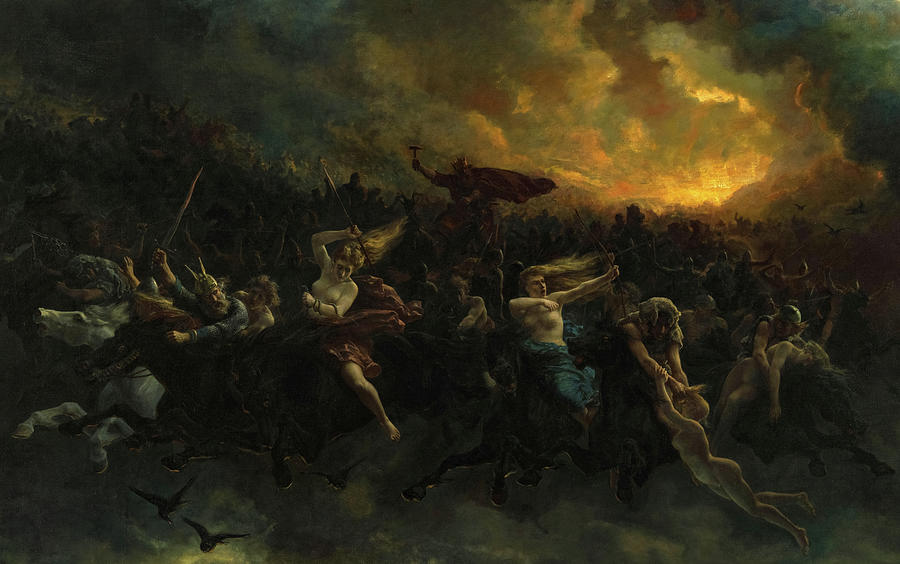
Norse Mythology is the body of pre-Christian stories from Denmark, Sweden, Norway and Iceland. After the Classical tradition, Norse mythology is the best preserved in Europe. Reaching their heyday in the Viking age, tales of the Norse gods still influence film and literature today.
Norse mythology comes from the northern branch of the paganism once followed in Germany, Scandinavia and England, and is by far the most extensive and best preserved.
Snorri Sturlusson, an Icelandic priest and politician, recorded the old oral tales in the Prose Edda in the 13th century. Unlike the monks who recorded the Slavic and Celtic myths around the same time, Sturlusson did not overtly Christianise this subject matter but told the Norse stories as is. We therefore know far more about them today.
The Poetic Edda, recorded in the same time, is a compilation of 31 poems by unknown authors and a key source.
Norse mythology preserves many old Indo-European motifs, including:
- a world tree
- a hound at the gates of the underworld
- dragon slaying heroes
- the wild hunt
- a prominant thunder god

Yggdrasil is the tree at the centre of the universe. A dragon called the Niddhog gnaws at its roots and from it forms nine worlds:
- Asgard – home of the Aesir
- Vanaheim – home of the Vanir
- Alfheim – home of the light elves
- Dokkalfheim – home of the dark elves
- Midgard – our world
- Jotunheim – home of the giants
- Svartalfheim – home of the dwarves
- Muspelheim – the world of fire
- Niflheim – the world of ice
The universe started in a collision of the primordial worlds of ice and fire. A giant called Ymir emerged from the ice, whom Odin – father of the gods – slew. His body formed the earth, and his blood the sea.
Jötnar (singular jötun), came from Ymir’s armpits. Commonly translated as ‘giants’, they have similar powers to the gods and represent antagonistic forces. While sometimes mentors, helpers or lovers to the Aesir, they are most often foes. As Odin, Loki and Tyr are half-Jötunn, the jötnar may have been a rival family of gods rather than different beings altogether.

Norsemen worshipped the Aesir. These include taciturn Odin, who sacrifices his right eye for knowledge, and hot-blooded Thor, who wields a hammer and protects humankind. The Aesir’s power surpasses humanity, but they are not immortal. They rely on golden apples to retain their youth and know when and how they will die.
Main Gods:
- Odin – god of wisdom, poetry and war.
- Thor – his son, god of thunder.
- Loki – god of mischief and deceit
- Freyja – goddess of magic, fertility and beauty.
- Freyr – her brother, god of fertility
- Njord – their father, god of the sea
- Heimdall – god of vigilance, watches the bridge between Asgard and the other worlds.
- Hel – Loki’s daughter, goddess of the underworld
- Frigg – Odin’s wife, goddess of motherhood and clairvoyance
- Baldr – their son, god of beauty.
Freyja, Frey and Njord were originally Vanir, a rival group of gods. After an inconclusive war, they went to live with the Aesir in Asgard.
In Icelandic, nouns have an ‘r’ at the end when they are the subject. So, for example, names like Odin and Njord are sometimes rendered Odinr and Njordr.
The Norse believed if they died in battle, female warriors called Valkyries would fly them to Valhalla, where they would feast all night and fight all day, only to be born again and again. Odin was raising an army for Ragnarok. Those who died of natural causes go to the dreary realm of Hel.
Loki, the trickster, is the enemy within. His scheming starts as simple mischief but grows more and more destructive. His shenanigans breed monstrous children who end up causing Armageddon.

Ragnarok is the end of the world. Norse mythology is unique in that it has an ending. In the final battle, the Aesir and their foes destroy each other and Asgard crumbles. Once the dust settles, however, the few survivors rebuild a new and better world.
See Also:
